Many of the historical sites and locations related to the Salem Witch Trials still exist in and around Salem as well as other areas.
Visiting these sites is a great way to experience the history of the trials firsthand.
The Salem Witch Trials took place in a settlement within the Massachusetts Bay Colony named Salem which, at the time of the trials in 1692, consisted of two sections: Salem town, which is now modern-day Salem, and Salem Village, which is now modern-day Danvers.
Many people like to argue that the witch trials didn’t really happen in Salem and instead took place in Danvers. This is not entirely true. The Salem Witch Trials did begin in Danvers, but the events of the trials actually took place in both Salem and Danvers.
The early events of the witch trials, particularly the first handful of accusations and pretrial examinations, occurred in Salem Village in March of 1692. The accusations and examinations then quickly spread to Salem town.
The majority of the accused witches were held in the jail in Salem town (as well as jails in Ipswich and Boston). The actual witch trial cases themselves were heard in the courthouse in Salem town and the convicted witches were executed and buried in Salem town (although a few of the bodies, such as Rebecca Nurse, John Proctor and George Jacobs Sr, were reportedly retrieved by their family members and reburied on their family properties in Salem Village.)
Although some of the events did happen in Danvers, one reason the town doesn’t get the massive influx of tourists like Salem does is because it doesn’t have the same name as the trials anymore (the town’s name was changed from Salem Village to Danvers in 1752.)

Another reason is because Danvers is a small suburban town and the locations of the Salem Witch Trials sites in Danvers are spread out over miles. They’re not conveniently clustered in the downtown area of a small city like they are in Salem.
Despite their numerous locations, the witch trials historic sites in Salem and outside of it are still easy to find and are well worth traveling to.
If you’re visiting Salem, you can see the sites there by simply following the heritage trail around the downtown area or by taking a Salem history tour.
There are also many other witch trials historic sites across the north shore of Massachusetts, which most can be reached by car or bus.
Some of these historical sites are well preserved and are frequently visited by tourists, but many of them are long forgotten. Only a few of these sites still have the original buildings from that time period. The other buildings have either fallen into ruins, burned down or were torn down to make way for more modern buildings.
The following is a list of historical sites related to the Salem Witch Trials, divided by town:
WENHAM, MASS:
♦ Claflin-Gerrish-Richards House:
Website: wenhammuseum.org
Address: 132 Main Street, Wenham, Mass
This was the home of Reverend Joseph Gerrish in 1692. It was here that Gerrish and Reverend John Hale met with one of Gerrish’s parishioners, Mary Herrick, who then accused Hale’s wife of witchcraft and said the ghost of Mary Easty visited her and told her she was executed unjustly.
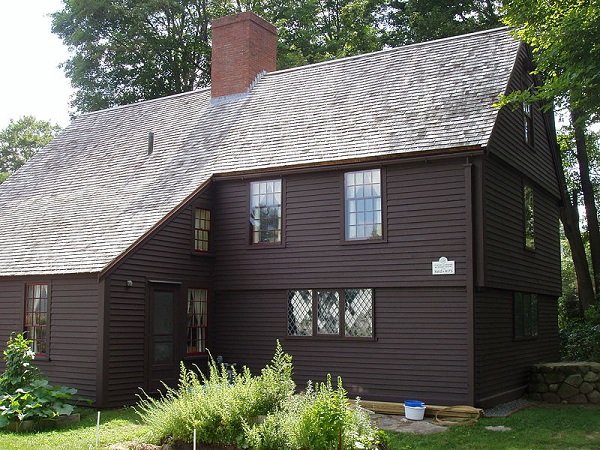
The house, which was built sometime between 1662-1673, still stands today and serves as the office of the Wenham Historical Association. It is open to the public.
Reverend Joseph Gerrish, Thomas Fisk & William Fisk’s Graves:
Address: Old Wenham Burying Ground, Wenham, Mass
Reverend Joseph Gerrish was buried here after he died in 1720 at the age of 70. Also buried here are Thomas Fisk, who died in 1723 at the age of 70, and William Fisk, who died in 1727 at the age of 85.
Both men were jurors in the Salem Witch Trials and both men reportedly signed a confession of error in 1697 stating that they were “sadly deluded and mistaken” during the trials.
Topsfield, Mass:
♦ Site of Sarah Wildes Home
Address: Triangular area between Perkins Row and Meetinghouse Lane, Topsfield, Mass
♦ Pierce Farm
Address: 116 Boston Street, Topsfield, Mass.
The foundation of Pierce Farm includes a section of of the 1690s farmhouse owned by Isaac Easty, son of Mary Easty. Mary Easty was arrested at this farmhouse in 1692.
SALEM, MASS:
♦ The Witch House:
Website: witchhouse.info
Address: 310 Essex St, Salem, Mass
The Witch House was the home of Jonathan Corwin who was a judge in the Salem Witch Trials. Corwin purchased the house in 1675 and lived there for 40 years until his death in 1718.

The house remained in the family until the 1850s when it was sold to a pharmacist named George Farrington who added a pharmacy to the side of the building.
In 1944, the building was moved back from the street about 35 feet to allow North street to be widened. The house was restored at the time to look as it would have in the 17th century. The house officially opened as a museum in 1946.
♦ Site of the Old Salem Jail:
Address: corner of St. Peter and Federal Street, Salem, Mass
The jail that the accused witches were kept in was a small wooden structure with a dungeon underneath.

The accused witches were considered very dangerous prisoners and were kept in the dungeon and chained to the walls to prevent their spirits from escaping and tormenting their victims.
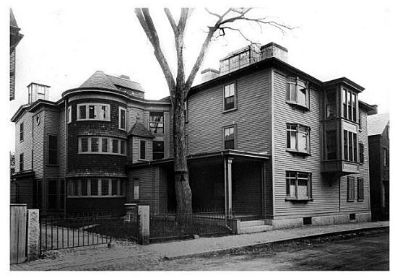
In 1813, the old witch jail was abandoned when a new jail was built down the street.
In 1863, Abner Cheney Goodell purchased the structure of the old jail and remodeled it into a home. In 1935, Goodall’s son Alfred and his wife began offering tours of the home and the old dungeon underneath.
In 1956, the New England Telephone Company razed the house and constructed their new headquarters, a large brick building, in its place.
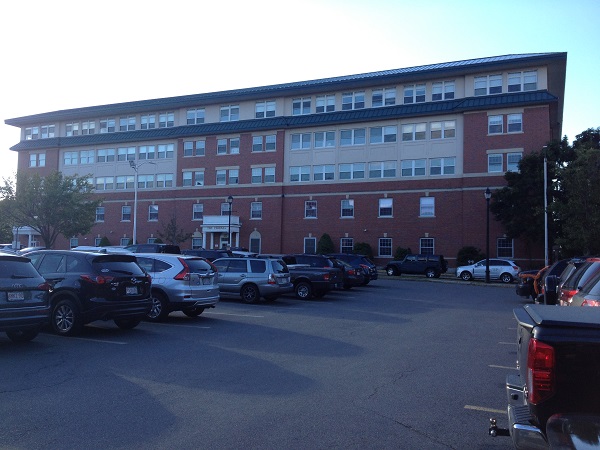
A plaque dedicated to the old jail can be found on the front of the brick building at 10 Federal Street.
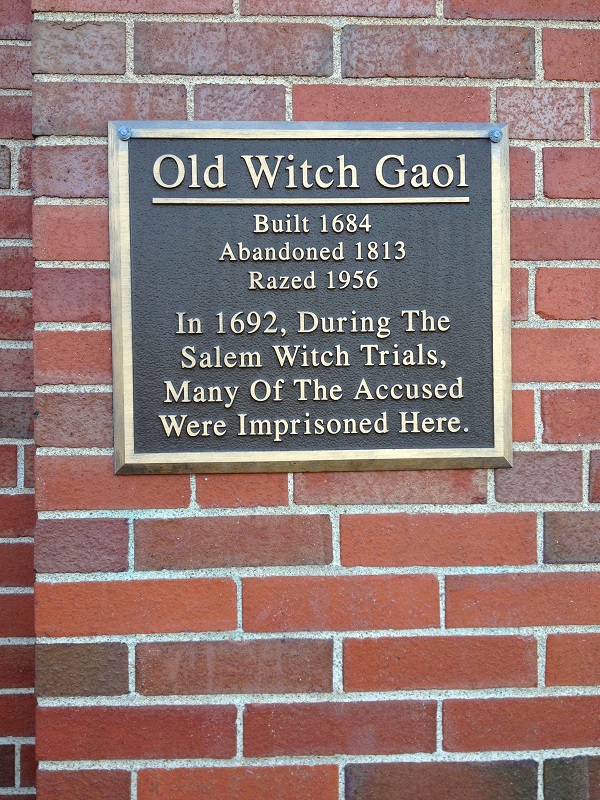
When construction workers were digging the new foundation for the brick building, they unearthed the old dungeon where the accused witches were kept.
Several wooden beams from the dungeon were recovered and donated to the Peabody Essex Museum. Two of these beams are now on display, one at the Salem Witch Museum and one at the Witch Dungeon Museum.
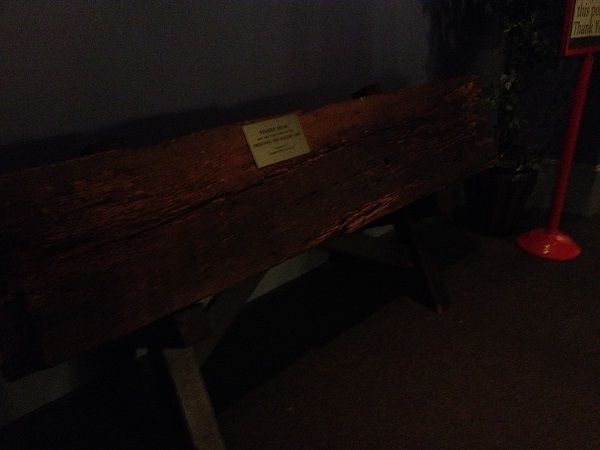
♦ Site of the Salem Courthouse:
Address: Washington Street (about 100 feet south of Lynde Street), opposite the Masonic Temple, Salem, Mass
The Salem Witch Trials cases were heard in the courthouse in Salem town located in the center of Washington Street about 100 feet south of Lynde Street, opposite of where the Masonic Temple now stands.
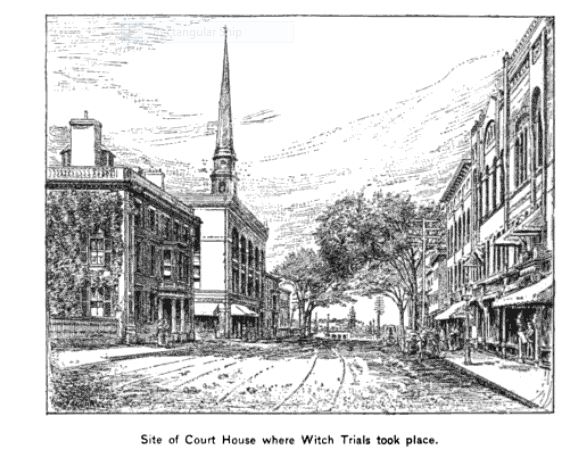
In 1760, this courthouse was torn down but a plaque dedicated to the courthouse can be found on the wall of the Masonic Temple on Washington Street.
♦ Site of Bridget Bishop’s Orchard & House:
Address: 43 Church Street, Salem, Mass. Currently occupied by Turner’s Seafood restaurant.
Bridget Bishop was the first person tried for witchcraft during the Salem Witch Trials. At or around the time of the witch trials, she lived in a house at 43 Church street where she also had an apple orchard. Some of her accusers reported seeing her spirit flying through the apple orchard at night, knocking apples off the trees as she flew.
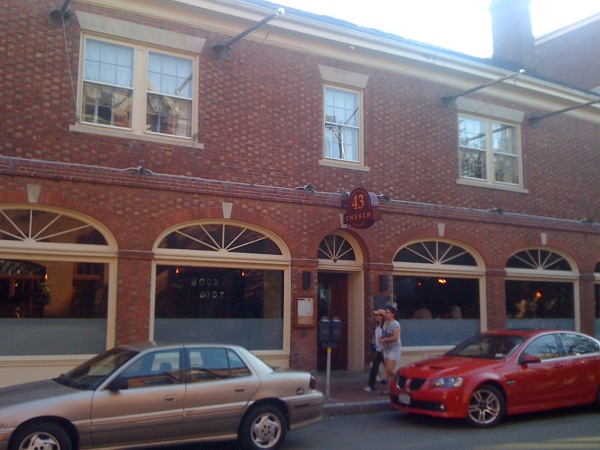
It is not known what happened to the house, but in 1831, the land was purchased by the Salem Lyceum Society who built the large brick building that still stands on this spot today.
The Lyceum building was used as a lecture hall and hosted such famous speakers as Henry David Thoreau, Frederick Douglass and Ralph Waldo Emerson. In 1877, the building hosted Alexander Graham Bell’s first public demonstration of the telephone. The building was later remodeled into a series of bars and restaurants.
♦ Site of Beadle’s Tavern:
Address: south side of Essex Street, opposite of Washington Square E, Salem, Mass
Beadle’s Tavern was owned by Salem resident Thomas Beadle. A few of the accused witches’ pretrial examinations were held in the tavern.
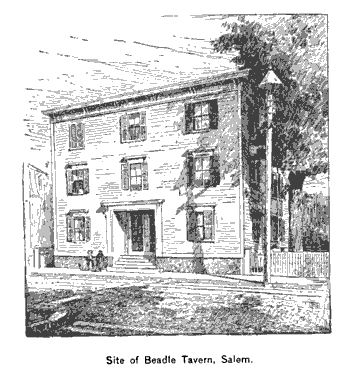
It is not known what happened to the tavern after the Salem Witch Trials but the building no longer exists.
♦ Site of Sheriff George Corwin’s House:
Address: 148 Washington Street, Salem, Mass
Sheriff George Corwin was the High Sheriff of Essex County at the time of the Salem Witch Trials. He lived in a house on a plot of land at what is now 148 Washington Street.
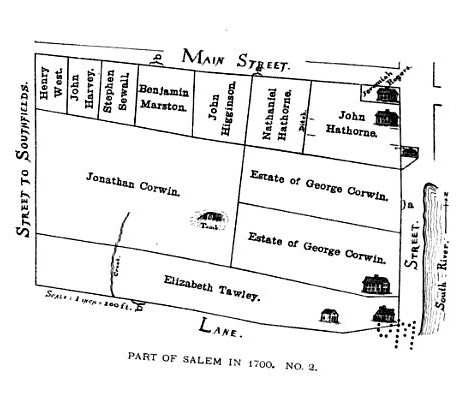
According to Upham in his book Salem Witchcraft, Corwin’s grandfather, also named George, previously lived in the house before moving into his newly built mansion on Essex Street in 1660. When Corwin died in 1685, he left the estate to Sheriff Corwin’s mother, Margaret. After she died sometime around 1691-92, Sheriff Corwin inherited it.
Sheriff Corwin died suddenly of a heart attack in 1696, at the age of 30, which is said to be the result of the Curse of Giles Corey, and left the estate to his wife. At the time Corwin died, surviving victims of the Salem Witch Trials, particularly Phillip English, were suing Corwin for damages after he confiscated goods and valuables of the accused during the witch trials.
Local legend says that English threatened to steal Corwin’s body and hold it for ransom. To prevent this from happening, Corwin’s family reportedly buried Corwin in the basement of his house. Corwin’s body was later reburied in the Corwin family tomb. When Corwin’s widow died in 1700, she left the estate to her son, Bartholomew Corwin.
Bartholomew sold the estate in 1714 and it changed hands a number of times over the next couple of decades until it was sold to local merchant Joshua Ward on August 11, 1781.
In 1784, Joshua Ward demolished Sheriff George Corwin’s house on the property and built a large brick mansion on the spot. This mansion still stands today and is currently a hotel known as The Merchant, named in honor of Joshua Ward.
♦ Judge Jonathan Corwin & Sheriff George Corwin’s Graves:
Address: Broad Street Cemetery, Broad Street, Salem, Mass
The Corwin family tomb is marked by a short obelisk dedicated to the Corwin family. Jonathan Corwin was buried here in the family tomb when he died in 1718 at the age of 76. George Corwin died in 1696 at the age of 30 but wasn’t buried here until a later date.
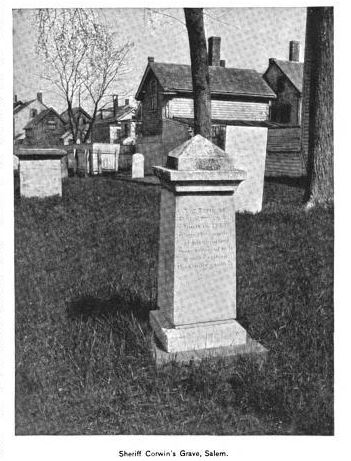
♦ Site of Judge John Hathorne’s Mansion:
Address: 114 Washington Street, Salem, Mass
John Hathorne was a notorious judge in the Salem Witch Trials. Hathorne purchased this land, on the corner of what is now Essex and Washington streets (where the Bewitched statue now stands), from Deacon John Marston, Sr, on August 25, 1685.

Hathorne also owned the land west of it, which he purchased from John Fogg in 1675. Hathorne divided the tract of land west of his lot into house lots and sold the lots individually to his son Nathaniel Hathorne, John Higgins, Benjamin Marston, Stephen Sewall, John Harvey and Henry West in May of 1699.
After John Hathorne died in 1717, his mansion and land remained in the Hathorne family for several generations until it was sold to a woman named Mrs. Ropes in 1764. John Hathorne’s mansion burned down in the great fire of October 6, 1774 which also destroyed a nearby meetinghouse, seven other homes and 14 stores.
♦ Judge John Hathorne’s Grave:
Address: Old Burying Point Cemetery, Charter Street, Salem, Mass
Judge John Hathorne was buried here after he died on May 10, 1717 at the age of 76.
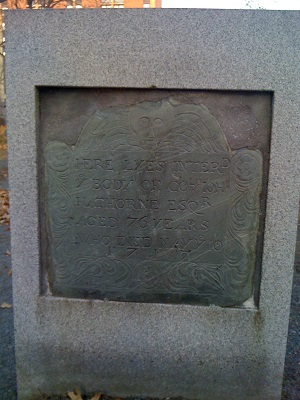
♦ Judge Bartholomew Gedney’s Grave:
Address: Old Burying Point Cemetery, Charter Street, Salem, Mass
Bartholomew Gedney was a local physician and a judge in the Salem Witch Trials. Gedney was buried here after he died in 1697 at the age of 57.
♦ Site of Giles Corey’s Death:
Address: Howard Street Cemetery, Howard Street, Salem, Mass
Giles Corey was a farmer from Salem Village who was accused of witchcraft in April of 1692. Corey was tortured here, which was then just a field next to the old Salem jail, in September of 1692 when he refused to enter a plea in his witchcraft trial.

Corey was forced to lie on the ground while a board was placed on top of him which was then loaded with heavy stones. Corey died here on September 19, 1692 after three days of torture.
♦ Site of Reverend John Higginson’s Estate:
Address: 19 ½ N Washington Square, Salem, Mass, currently occupied by the Salem Witch Museum.
Reverend John Higginson was the senior minister in Salem town at the time of the Salem Witch Trials. He owned the property that the Salem Witch Museum now sits on.
He also had a house nearby, on what is now Essex Street, where he lived with his daughter, Ann Higginson Dolliver, who was accused of witchcraft in June of 1692. Ann later confessed to the crime and was released. John Higginson himself also provided testimony in defense of an accused witch named Sarah Buckley.
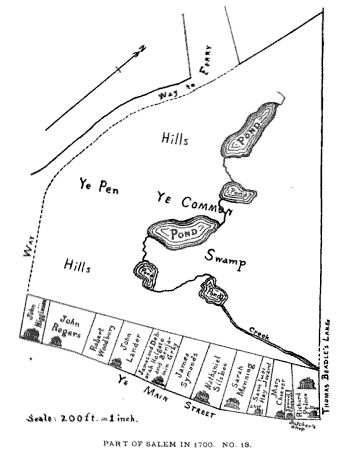
The land Higginson owned was later purchased by the East Church who built a Gothic Revival-style church there, between 1844-1846, which still stands today.
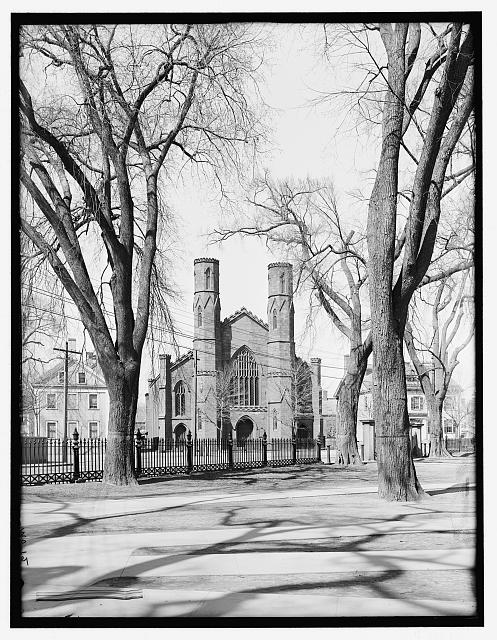
In 1972, the new owners of the property, Holly and Tom Mulvihill, opened the Salem Witch Museum in the old church building to appeal to the new tourists flocking to Salem after the publication of The Crucible and the airing of the “Salem Saga” episodes of Bewitched.
♦ Site of Ann Pudeator’s House:
Address: 35 N Washington Square, Salem, Mass
Ann Pudeator was a widow and midwife who was accused of witchcraft in May of 1692 and hanged on September 22, 1692.
At the time of the witch trials, Pudeator lived in a home at this address. It is not known what happened to the home but a Federal-era brick mansion now stands on this spot.
♦ William Murray’s House:
Address: 39 Essex Street, Salem, Mass. No admission. Privately owned home
William Murray served as a court clerk in the Salem Witch Trials and also provided testimony against accused witch Alice Parker.
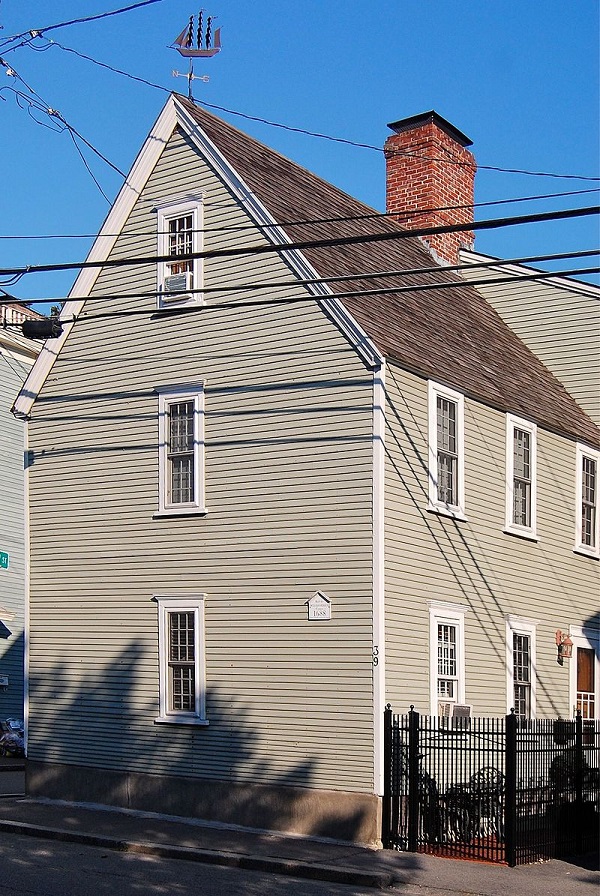
At the time of the witch trials, Murray was living in this house, which was built in 1688. The building has been heavily renovated since it was first built. The building is now privately owned.
♦ Former Site of Alice Parker’s House:
Address: English Street, Salem, Mass. Exact location is believed to have been in what is now the parking lot behind the fence of the Salem Harbor Power Station.
Alice Parker was accused of witchcraft in May of 1692. At the time of the witch trials, she was living in a house, located somewhere on this spot, which she rented from fellow witch trial victim Phillip English.
Parker was found guilty and hanged at Proctor’s Ledge on September 22, 1692. It is not known what happened to her house after the witch trials but it no longer exists.
♦ Site of Reverend Nicholas Noyes Home
Address: 90 Washington Street, Salem, Mass.(Southern corner of Washington and Lynde Streets)
Site previously occupied by a large wooden house owned by Rev. Nicholas Noyes who officiated as the clergymen at many of the Salem Witch Trials executions. It is not known what happened to the house but in 1764, Judge Benjamin Pickman built a large brick house there. The spot is currently occupied by a commercial building.
♦ Site of First Church of Salem Meetinghouse
Address: 231 Essex Street, Salem, Mass
Many of the examinations that took place in Salem town were held at this meetinghouse, including Elizabeth Proctor’s examination on April 11, 1692. Also, on June 2, 1692, when Bridget Bishop was escorted from the Salem jail to the courthouse she glanced at the meetinghouse at the same moment that something crashed inside. When a board was later found out of place many believed it was confirmation that Bishop was a witch. Also, on July 3, 1692, Rebecca Nurse was excommunicated by Reverend Nicholas Noyes at this meetinghouse as was Giles Corey in September. A memorial plaque is located on the northeast corner of the brick building that occupies this spot today.
♦ Site of the Salem Witch Trials Executions:
Address: Proctor’s Ledge, small hill between Proctor and Pope Street, Salem, Mass
A total of 19 convicted witches were hanged at Proctor’s Ledge, a small hill near Gallows Hill, between June and September of 1692. The Proctor’s Ledge Memorial was built at the foot of the hill in 2017.
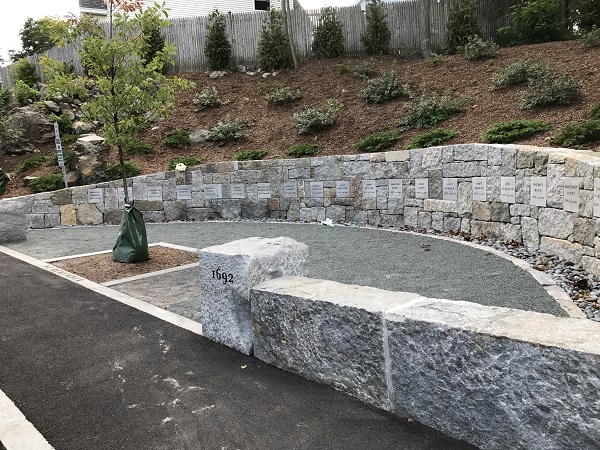
♦ Site of Philip English’s Mansion:
Address: 11 Essex Street, Salem, Mass
Phillip English was a wealthy merchant who was accused of witchcraft in April of 1692. At the time of the trials, English lived in a large mansion on Essex Street which he built in 1686.
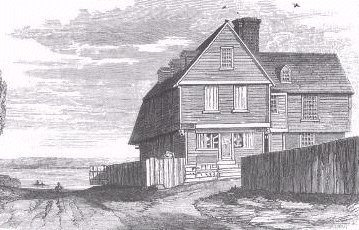
After English was arrested in May, he managed to escape the Boston jail with his wife and fled to New York. He later returned to Salem after the witch trials ended. English’s mansion stood for almost 150 years until it was razed around 1833.
♦ Phillip English’s Grave:
Address: St Peter’s Episcopal Church, 24 St. Peter Street, Salem, Mass
In 1733, Phillip English donated a section of land, on the corner of Brown and St. Peter Street, to build a small wooden church called the St. Peter’s Episcopal Church. A small cemetery was also established around the church in which Phillip English was buried when he died in 1736.
In 1833, the wooden church was taken down and the stone church that exists there now was built in its place. The new church was much larger than the old one and, as a result, it was built on top of some of the graves in the cemetery, including English’s grave. English’s body is buried underneath the church’s chapel and a small exhibit in his honor can be found inside the church.
♦ Salem Witch Trials Memorial:
Address: Liberty Street, Salem, Mass
The Salem Witch Trials Memorial was built in 1992 to honor the victims of the Salem Witch Trials and mark the 300th anniversary of the Salem Witch Trials.
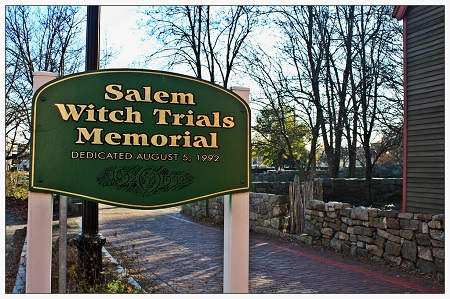
The memorial was dedicated by Nobel laureate-winner and Holocaust survivor Elie Wiesel in August of 1992 as part of the Salem Witch Trials Tercentenary. The memorial is adjacent to the Old Burying Point Cemetery where Judge John Hathorne is buried.
SALISBURY, MASS:
♦ Major Robert Pike’s Grave:
Address: Salisbury Colonial Burying Ground, Beach Road, Salisbury, Mass
Major Robert Pike was one of the most prominent citizens of Salisbury, Mass and served as an assistant for the colony and a Justice of the Peace. Pike recorded most of the testimony given against Susannah Martin.
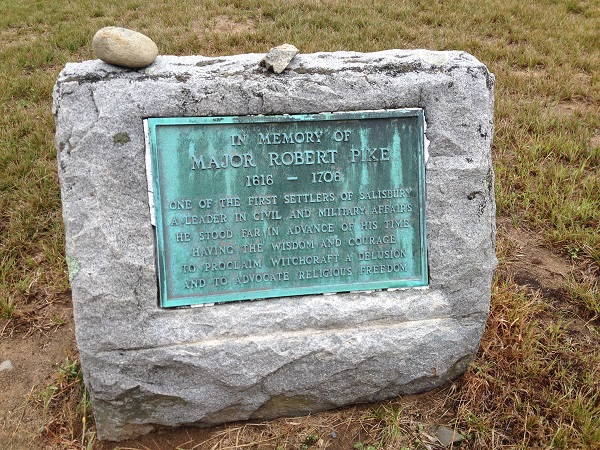
In August of 1692, Pike wrote a letter to Judge Jonathan Corwin attacking the validity of spectral evidence and criticized the logic of the trials by asking why the accused would deny they are witches but then practice witchcraft “in the sight of all men, when they know their lives lie at stake by doing it? Self-interest teaches everyone better.”
Pike also signed an affidavit in defense of another Salisbury woman accused of witchcraft, Mary Bradbury, who was his son’s mother-in-law. Pike was buried here after he died in 1706 at the age of 90.
♦ Mary Perkins Bradbury’s Grave
Address: Salisbury Colonial Burying Ground, Beach Road, Salisbury, Mass
Mary Perkins Bradbury was the wife of Captain Thomas Bradbury of Salisbury and was accused of witchcraft by the afflicted girls of Salem Village in July of 1692.
Bradbury was tried and convicted of witchcraft in September but her execution was delayed and she was eventually released. She was buried here after she died of old age sometime around or just prior to the year 1700.
PEABODY, MASS:
♦ Site of John Proctor’s Farm:
Address: Lowell Street, one-tenth mile south of Prospect Street, Peabody, Mass. No admission. Privately owned land.
John Proctor was the first male accused of witchcraft during the Salem Witch Trials. He was accused in April of 1692 during his wife Elizabeth Proctor’s examination.
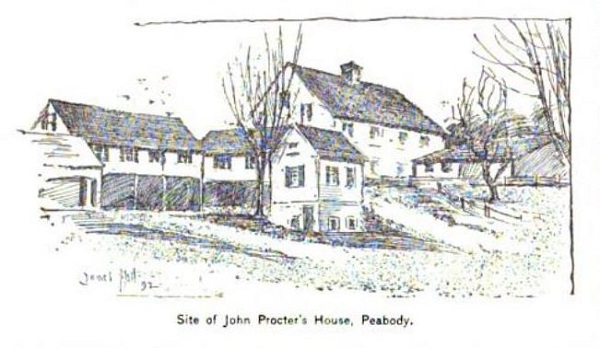
At the time, the Proctor family was living on this farm, where Proctor also ran a tavern called the Proctor Tavern, in what was then the outskirts of Salem Village.
After Proctor’s arrest, Sheriff George Corwin raided the farm and confiscated all of the beer, food and valuables on the property.
John Proctor was found guilty on August 5 and executed on August 19, 1692 at Proctor’s Ledge in Salem. Proctor’s family reportedly retrieved his body from the execution site and buried it on the northeast corner of the family farm.
The farm was later passed down to Proctor’s son, Benjamin, and it remained in the family until the late 1800s. It is not known what happened to Proctor’s original house but there is another house still standing on the property that is often referred to as the John Proctor house despite the fact that historians believe it was built in the 1700s by Proctor’s son Thorndike Proctor. The house and the farm are privately owned.
♦ Nathaniel Felton, Sr, House:
Website: www.peabodyhistorical.org
Address: 47 Felton Street, Peabody, Mass
Hours: Open by appointment only
Nathaniel Felton, Sr, was a neighbor of John Proctor. He came to the defense of John and Elizabeth Proctor and Rebecca Nurse in 1692 when he signed a petition calling for their release from jail. At the time of the witch trials, Felton was living in this house in Peabody.

The house was built in 1644, making it the oldest house in Peabody. The house remained in the Felton family for over two centuries until 1902 when it was sold a wealthy shoe manufacturer named Joseph Smith. In 1983, the widow of Joseph Smith’s grandson gave the house to the Peabody Historical Society who later opened it up as a historic house museum.
♦ Nathaniel Felton, Jr, House:
Website: www.peabodyhistorical.org
Address: 43 Felton Street, Peabody, Mass
Hours: Open by appointment only
Nathaniel Felton, Jr, also came to the defense of accused witches John and Elizabeth Proctor and Rebecca Nurse. At the time of the witch trials, Felton, Jr., was living in this house in Peabody.
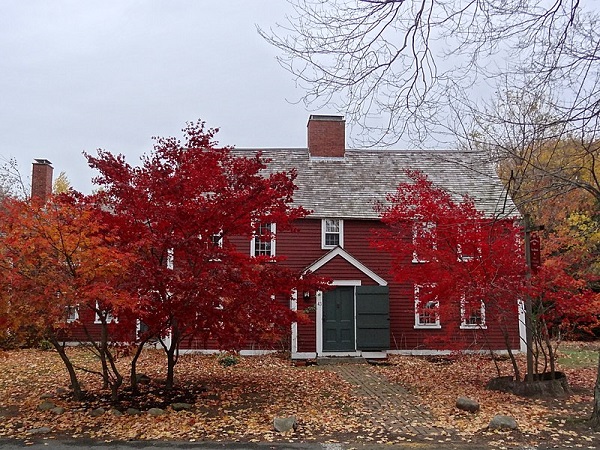
The house was built in 1683 and remained in the Felton family for almost two centuries until 1902 when it was sold a wealthy shoe manufacturer named Joseph Smith. In 1976, the widow of Joseph Smith’s grandson gave the house to the Peabody Historical Society.
♦ Giles and Martha Corey Memorial Markers:
Address: off of Lowell Street, near Crystal Lake in Peabody, Mass
Two memorial markers dedicated to Giles and Martha Corey are located here near the former site of the Corey farm.

MARBLEHEAD, MASS:
♦ Site of Wilmot Redd’s House:
Address: corner of Pond and Norman Streets, Old Burial Hill near Redd’s Pond, Marblehead, Mass
Wilmot Redd was the wife of a Marblehead fisherman. She was accused of witchcraft in May of 1692 and brought to Ingersoll Tavern in Salem Village to be examined by a judge.
At the time of her arrest, she was living in a house next to Old Burial Hill in Marblehead, on the southeast corner of what is now Redd’s pond. Redd was found guilty in September and was among the last victims of the witch trials when she was hanged on September 22, 1692.
It is not known what happened to Redd’s house after the witch trials but the house no longer exists. The pond near the site of her home was later named after Redd. There is also a memorial marker for Wilmot Redd located on Old Burial Hill.
♦ Ambrose Gale House:
Website: www.marbleheadhistory.org
Address: 17 Franklin Street, Marblehead, Mass
Ambrose Gale was a Marblehead fisherman and merchant who testified against Wilmot Redd during the Salem Witch Trials. According to the Marblehead Historical Commission’s website, Gale was living in this house in Marblehead at the time of the trials.
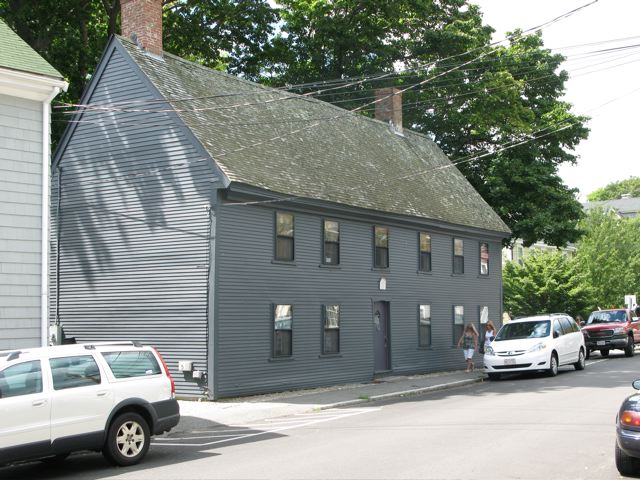
Built in 1663, it is the oldest house in Marblehead and it is currently owned by the Marblehead Historical Commission.
IPSWICH, MASS:
♦ Former Site of the James & Elizabeth Howe Farm:
Address: 417 Linebrook Road, Ipswich, Mass
Elizabeth Howe was a woman from Topsfield who was accused of witchcraft in May of 1692. At the time she was living on this farm with her children and blind husband.
After Howe was arrested she was brought to Ingersoll Tavern in Salem Village to be examined by Judge John Hathorne and Judge Jonathan Corwin. She was indicted on two charges of witchcraft and led to jail, probably either the Salem jail or a jail in Ipswich. Howe was found guilty and hanged at Proctor’s Ledge on July 19, 1692.
The farm remained in the family for several generations. In 1911, the former location of the Howe homestead on the farm was discovered by a writer investigating the history of the Salem Witch Trials.
The site of the homestead at the time was only a hole in the ground where the cellar used to be. The Howe descendants living on the property at the time referred to it as Mary’s hole, after Elizabeth Howe’s daughter, Mary, who lived in the house after her mother’s execution. The site was later excavated in 2006.
HAVERHILL, MASS:
♦ Major Nathaniel Saltonstall’s Grave:
Address: corner of Water and Mill Streets, Pentucket Cemetery, Haverhill, Mass
Major Nathaniel Saltonstall was a judge in the Salem Witch Trials. Saltonstall resigned from the court in June of 1692 and was replaced by Judge Jonathan Corwin.
After his resignation, Saltonstall became a prominent critic of the trials. He was then accused of witchcraft himself but never stood trial. Saltonstall was buried here after he died in 1707 of a consumptive illness.
DORCHESTER, MASS:
♦ Chief Justice William Stoughton’s Grave:
Address: corner of Stoughton Street and Columbia Road in Dorchester, Old Burying Ground, Dorchester, Mass
William Stoughton was the Chief Justice in the Salem Witch Trials. Stoughton was buried here after he died in 1701 at the age of 70.
DANVERS, MASS:
♦ Rebecca Nurse Homestead:
Website: www.rebeccanurse.org
Address: 149 Pine Street, Danvers, Mass
Rebecca Nurse was an elderly grandmother from Salem Village who was accused of witchcraft in March of 1692. At the time of the witch trials, she lived in this large house which then sat on 300 acres of land.

The house is the only home of a person executed during the trials that is open to the public. The house and farm were originally established in 1636 by Townshend Bishop when he was granted 300 acres of land in Salem Village.
In 1641, Bishop sold the estate to Henry Chickering who then sold it to Governor Endicott in 1648 for one hundred and sixty pounds. Endicott gave the farm to his son, John, in 1653.
John died in 1668 and he left it to his wife, who then married Reverend Samuel Allen of the First Church of Salem. When she died in 1673, the farm became the property of Allen who sold it to Francis Nurse, Rebecca’s husband, in 1678.
After Rebecca Nurse was accused of witchcraft in 1692, she was arrested at the house on March 23 and was lodged at Ingersoll’s tavern for the night before being examined at the tavern the next day.
Rebecca Nurse never returned to her house again and was hanged on July 19, 1692 at Proctor’s Ledge in Salem town. The farm stayed in the Nurse family until it was inherited by the Putnam family in 1784.
In 1908, the Rebecca Nurse Memorial Association purchased the house and 27 acres to preserve it. In 1909, the house underwent a renovation by the architect Joseph Chandler. The house was opened to the public in 1909 as Danvers’ first historic house museum.
Also located on the property is the Nurse family cemetery which reportedly is the location of Rebecca Nurse’s unmarked grave. Family legend states that Nurse’s son secretly retrieved her body from the execution site and buried her in the family cemetery.
In 1992, a body believed to be that of fellow witch trials victim, George Jacobs, was moved to the Nurse family cemetery after it was discovered on the nearby Jacobs property.
In 1885, the Nurse family association erected a granite obelisk monument in the cemetery in Nurse’s honor. In 1926, the association gave the property to the Society for the Preservation of New England Antiquities.
In 1981, the Danvers Alarm List Company, a colonial history organization, bought the property to preserve and restore it to its colonial-era appearance. Since then, the company has been slowly restoring the building, removing modern fixtures, re-establishing the original land contour, building period fencing, and re-establishing the kitchen garden and orchard.
♦ Salem Village Parsonage Archaeological Site:
Address: Rear 67 Centre Street, Danvers, Mass (site is accessible via a cart path.)
This was the site of the Salem Village Parsonage where Reverend Samuel Parris, his daughter Betty Parris, his niece Abigail Williams and his slaves Tituba and John Indian lived during the Salem Witch Trials. After the trials ended, the Parris family moved away and a new minister was appointed.
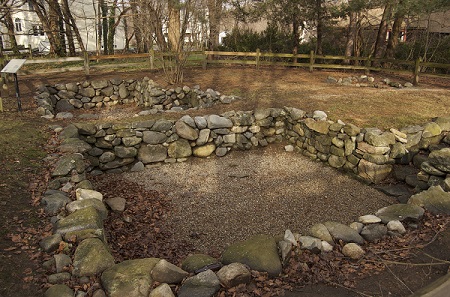
It is not known what happened to the original parsonage, but by the 19th century the building was gone and the land was being used for agricultural purposes. During the 19th century and most of the 20th century, the exact location of the old parsonage was marked only by a small granite marker.
In 1970, local historian and archivist Richard B. Trask excavated the site of the old parsonage and the site is now open to visitors.
♦ Sarah Osbourn House:
Address: 273 Maple Street, Danvers, Mass. No admission. Privately owned home.
Sarah Osbourn was one of the first women accused in the Salem Witch Trials when she was accused in February of 1692. She was examined before a judge, along with Tituba and Sarah Good, at the Salem Village Meetinghouse on March 1, 1692. Osbourn never stood trial because she died in jail shortly after.
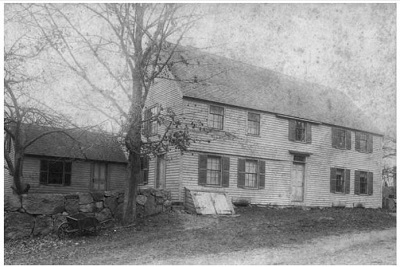
At the time of her arrest, Osbourn was living in this house, which was then located on Spring Street. The house was built sometime between 1660-1680. In 1914, it was moved from Spring Street to Maple Street. Not much is known about the history of the house before or after the Salem Witch Trials except that it is now a privately owned home.
♦ Sarah Holten House:
Website: www.dar.org
Address: 171 Holten Street, Danvers, Mass
Hours: Open by appointment only
Sarah Holten was a a woman who gave damaging testimony against Rebecca Nurse during the Salem Witch Trials. During the time of the trials, Holten lived in this house on what is now Holten Street.
The house was originally built in 1670. It was later also the home of Judge Samuel Holten, a physician, statesman and judge, who was a signer of the Articles of Confederation and served in the Continental Congress in the 1770s and 1780s. The house in now owned by the General Israel Putnam Chapter of the Daughters of the American Revolution.
♦ Former Site of George Jacobs’ House:
Address: Margin Street, Danvers, Mass
George Jacobs, Sr, was an elderly grandfather living in Salem Village when he was accused of witchcraft in May of 1692. He was arrested at his house alongside his granddaughter, Margaret, who was also accused and was examined by Judge John Hathorne and Judge Jonathan Corwin. Jacobs was indicted on two charges of witchcraft and brought to jail.
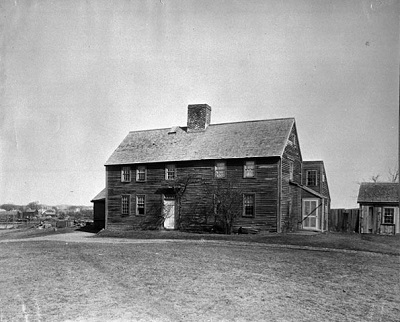
At the time of the witch trials, Jacobs was living in a center-chimney farmhouse on Margin Street that he built in the late 1600s. Jacobs was later found guilty and executed on August 19, 1692. According to family legend, his body was secretly retrieved from the execution site and buried on the family property.
The house survived until the early 20th century but became neglected and rundown by 1938 and was demolished sometime around 1940. In 1992, an unidentified body believed to be Jacobs was found on the property and moved to the Nurse homestead so the property could be sold.
♦ Ingersoll Tavern:
Address: 199 Hobart Street, Danvers, Mass. No admission. Privately owned home.
This was the former home of Deacon Nathaniel Ingersoll. Ingersoll also ran a tavern from this house during the time of the Salem Witch Trials. Some of the accused witches were examined before a judge at Ingersoll’s Tavern before they were brought to trial.
The house remained a tavern until either the late 1700s or early 1800s but eventually became rundown and was purchased by the First Church of Salem in 1832 and renovated to become a parsonage. The house is still standing but is a privately owned home.
♦ Salem Village Witchcraft Victims’ Memorial:
Address: 176 Hobart Street, Danvers, Mass
This memorial was built in 1992 to honor the victims of the Salem Witch Trials and mark the 300th anniversary of the trials. It was built on Hobart street, opposite of the former site of the Salem Village Meetinghouse.

The memorial was dedicated in May of 1992, during the Danvers Witchcraft Tercentennial Commemoration.
♦ Former Site of the Salem Village Meetinghouse:
Address: Near corner of Hobart and Forest Street, Danvers, Mass. Historical marker on site.
This is the site of the Salem Village Meetinghouse where some of the accused witches were examined before a judge before they were brought to jail.

The meetinghouse was abandoned and then moved across the street and re-purposed into a barn but slowly fell into ruins. By the mid 1800s the building was gone. A historical marker is located on site. A replica of the Salem Village Meetinghouse can be found at the Rebecca Nurse Homestead in Danvers.
♦ Former Site of the Salem Village Church:
Address: Corner of Hobart Street and Centre Street, Danvers, Mass
This is the site of the Salem Village Church where some of the accused witches and their accusers attended church during the Salem Witch Trials.
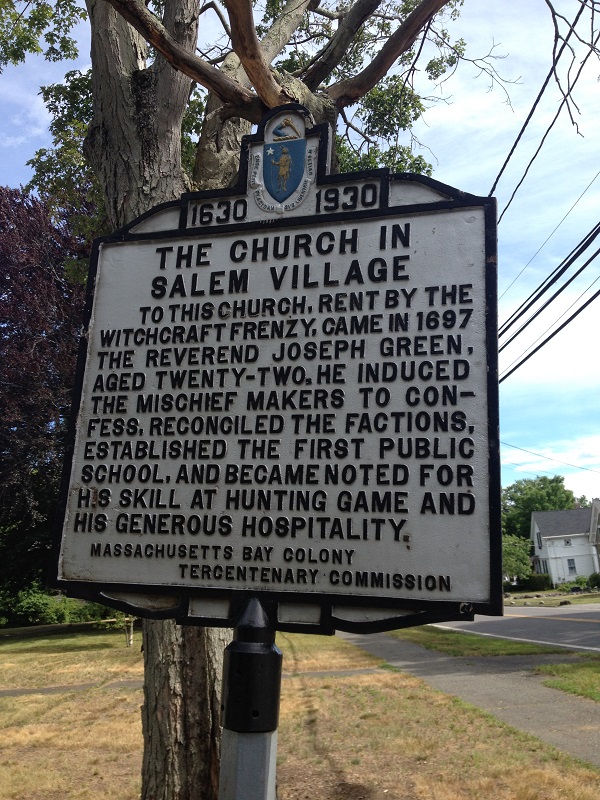
Some of the afflicted girls exhibited symptoms of their affliction during services here in the spring of 1692 and some of the accused where excommunicated here. A historical marker is located on the site. The First Church of Danvers Congregational now occupies the spot.
♦ Ann Putnam, Jr, Ann Putnam, Sr, & Thomas Putnam’s Graves:
Address: Putnam burial ground, 485 Maple Street, Danvers, Mass
The Putnam family were the main accusers during the Salem Witch Trials. Thomas Putnam was buried here after he died in May of 1699 at the age of 47. His wife Ann Putnam, Sr., was buried here a few weeks later in June of 1699. Their daughter, Ann Putnam, Jr, was buried here after she died in 1716 at the age of 37. Their graves are unmarked.
BEVERLY, MASS:
♦ Reverend John Hale Farm:
Website: www.beverlyhistory.org
Address: 9 Hale Street, Beverly, Mass
Hours: June-October: Saturdays 11am to 3pm.
July-August: Fridays & Saturdays: 11am-3pm.
Reverend John Hale was a minister from Beverly who assisted court officials during the Salem Witch Trials. Hale later became a critic of the witch trials after his wife was accused of witchcraft.
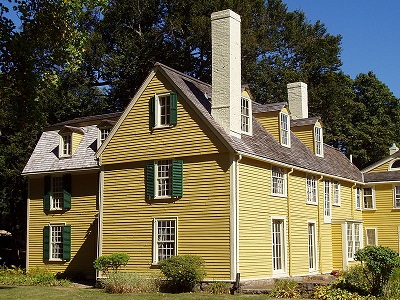
At the time of the trials, he was living in this farmhouse in Beverly, which had been deeded to him along with 200 acres of land by his parish. After the witch trials ended, Hale wrote a book about the trials, titled A Modest Inquiry Into the Nature of Witchcraft, which was published posthumously in 1702. Hale died in this home on May 15, 1700.
The farm remained in the family for several generations and many renovations and alterations were made to the house over the years. In 1937, it was sold to the Beverly Historical Society and was opened to the public as a historic house museum.
♦ Reverend John Hale’s grave:
Address: Abbott Street Burial Ground, Beverly, Mass
Reverend John Hale was buried here after he died in 1700 at the age of 64.
BOSTON, MASS:
♦ Judge Samuel Sewall’s Grave:
Address: Tremont Street, Granary Burying Ground, Boston, Mass
Samuel Sewall was a judge in the Salem Witch Trials. Sewall later issued a public apology for his role in the trials on January 15, 1697, during an official day of prayer and fasting in honor of the witch trial victims. Sewall was buried here after he died on January 1, 1730 at the age of 78.
♦ Cotton Mather’s Grave:
Address: Copp’s Hill Burying Ground, 45 Hull Street, Boston, Mass
Cotton Mather was a Boston minister who assisted the court during the Salem Witch Trials. Mather later wrote a book about the trials, titled Wonders of the Invisible World. Mather was buried here when he died in 1728 at the age of 65.
AMESBURY, MASS:
♦ Site of Susannah Martin’s house:
Address: end of North Martin Road, Amesbury, Mass
Susannah Martin was a poor widow living in Amesbury when she was accused of witchcraft in May of 1692. She was arrested and brought to Salem Village where she was examined by Judge John Hathorne and Judge Jonathan Corwin. She was indicted on two charges of witchcraft and led to jail.
At the time of the witch trials, Martin was living in a home on what is now North Martin Road. Martin was found guilty and executed on July 19, 1692. It is not known what happened to the house after the witch trials but Amesbury residents later placed a large boulder with a memorial plaque near the former site of her home.
Andover, Mass:
♦ Benjamin Abbott House
Address: 9 Andover Street, Andover, Mass.
Admission: Private home. No Admission.
Home of Benjamin Abbott who accused Martha Carrier of bewitching him.
♦ Old North Parish Burial Ground
Address: Academy Road, North Andover, Mass.
Admission: Free admission.
Burial place of the afflicted person Timothy Swan as well as Andover minister during the Salem Witch Trials, Rev. Thomas Barnard, and accused witches William Barker Sr and William Barker Jr.
If you’d like to learn about more historic sites in the state, check out this article on Massachusetts historic sites.
Sources:
“Reverend Nicholes Noyes Home, Site Of.” Salem Witch Museum, salemwitchmuseum.com/locations/reverend-nicholas-noyes-home-site-of/
“Judge Samuel Holten House.” Essex National Heritage Area, www.essexheritage.org/attractions/judge-samuel-holten-house
“Witchcraft Victim’s Memorial.” Danvers Archival Center, Peabody Institute Library and Richard Trask, www.danverslibrary.org/archive/?page_id=750
“Witch Trials Self-Guided Tour.” Salem Witch Museum, www.salemwitchmuseum.com/SitesTour
“Historical Sites of Danvers.” Salem Witch Trials Documentary Archive and Transcription Project, University of Virginia, n.d., salem.lib.virginia.edu/Danvers.html
“Redd’s Pond.” Old Burial Hill, www.oldburialhill.org/redds/redds_pond_01a.html
Swift, Adam. “A Walking Tour of Salem Witch Sites with the Salem Historical Society.” Salem Patch, 29 Oct. 2015, patch.com/massachusetts/salem/walking-tour-witch-sites-salem-salem-historical-society-0
Larkin, Jack. Where We Lived: Discovering the Places We Once Called Home. The Taunton Press, 2006.
Historical Collections of the Danvers Historical Society, Volumes 6-9. Danvers Historical Society, 1918.
Drake, Samuel Adams. Our Colonial Homes. Lee and Shepard, 1894.
Robinson, John. Visitors’ Guide to Salem. Essex Institute, 1895.
The Essex Antiquarian, Volume 3. Edited by Sidney Perley. The Essex Antiquarian, 1899.
Goss, K. David. Salem Witch Trials: A Reference Guide. Greenwood Press, 2008.
Trask, Richard B. Danvers. Arcadia Publishing, 2002.
Historical Collections of the Danvers Historical Society. Vols. 3-5. Danvers Historical Society, 1915.
Perley, Sidney. The History of Salem, Massachusetts: 1671-1716. S. Perley, 1928.
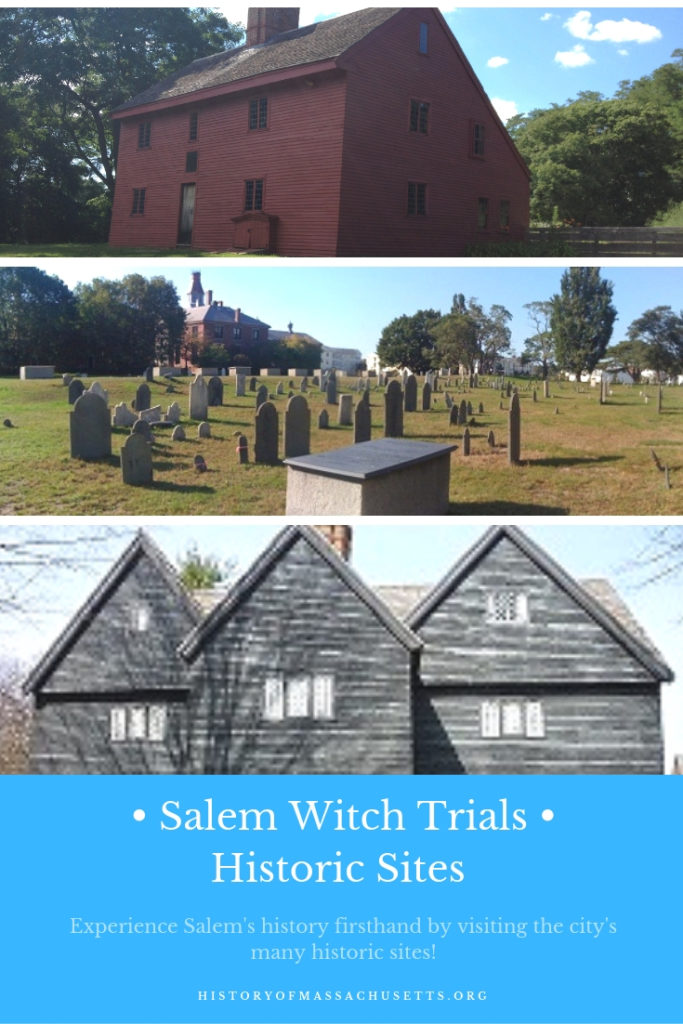

Thank you for posting this interesting material!
You’re welcome, John. I’m glad you liked it.
This was a great article. My step daughter went to Salem on a field trip just last week. I wish I had found this sooner! I’m going to go next week because I haven’t been there since I was a kid
Thanks Mike! Glad you liked the article. Hope you have fun in Salem next week!
Interesting and excellent information. Thank you!
I’m doing considerable family history work…
I discovered recently is that have a family connection to two individuals mentioned… 1) Capt. Thomas Fisk (jury foreman for the Rebecca Nurse trial) is my direct 8th Great Grandfather. 2) Giles Corey apparently killed Jacob Goodale around 1676. Jacob was the son of my 10th Great Grand Parents (Robert Goodale and Catherine -Kilham- Goodale). I am also directly related to Henry Herrick (juror on the Rebecca Nurse trial that eventually convicted her) and to Joshua Rea (signed a petition to save Rebecca Nurse).
Are you related to any Witch Trial connected individuals?
I plan to visit the Nurse and the Rea homesteads in the spring. Any additional advice? (e.g., grave sites, other homes).
Hi Guy,
Thanks for your comment. As far as I know I’m not related to anyone involved in the witch trials (although some of my ancestors, the Fitchs, lived in the area at the time and had the same last name as some of the accusers in Esther Elwell’s case – so perhaps but I can’t find any evidence of it.) I included everything I know about the witch trial locations in this article so I don’t really have any additional advice except that one place I didn’t mention in the article is the General Israel Putnam house at 431 Maple Street in Danvers. Joseph Putnam lived there are the time but, unlike the other Putnams, he was a critic of the trials and refused to participate. His son Israel was born in the house and he later became a notable general in the American Revolution. The house is unfortunately closed due to a lack of funding but you can still view it from the street.
Anyway I can find more about judge Jonathan Corwin… We share the very same name and a few weird details! Thank you!
Great timing, Jonathan! I just wrote an article on Jonathan Corwin and plan on publishing it in about a week or so. Check the blog during the last week of January or subscribe to my email list to get all the latest articles delivered right to your inbox. You can also search for Corwin’s name in the search box at the top of the page for a handful of articles I wrote that mention Corwin, including an article I recently wrote about the Witch House in Salem.
Do you have anhything regard what haooened to the afflicted girls? Like their life after the trials and if yhey were punished for their crimes?
Hi Sammy, I’ve written several articles about specific afflicted girls including this one about Ann Putnam, Jr: https://historyofmassachusetts.org/ann-putnam-jr/. That article contains links to the other articles about the girls.
Your research on Thomas Beadle’s Tavern conflicts with research I found at the Phillips Library some years ago.
There is a drawing, different from the one you have, and the book states the Tavern was “west of Daniels”, across from now Washington Square East; then Thomas Beadle’s Lane. From the drawing, it may be the house that is set back from
Essex and borders the Salem Maritime site.
I have copies of the information if you are interested.
Hi Blaire, yes I am definitely interested. I’ll email you.
Hi, I’m doing a project on the Salem Witch trials. Thanks so much for making this for everyone to read. It was very useful and helpful. Have a great day!!
You’re welcome, Nola!
i am very annoyed simply because todays salem is taking credit to many vistors that this was where all of the witch hystera took place when actually most occured in salem village [ danvers now). If you don’t have a car you are out of luck to see these sites of interest as there is no touring bus that can take you there which i am sure there are many that would actually like to see the real sites. I think it a shame ! Most vistors think that present day Salem is where it all happened when it really didn’t ! They need to have a tour bus that would take those interested and i am sure there would be many without taking away other attractions that Salem has to offer.
The trials happened in both Salem and Danvers. It is true that many of the early accused and accusers lived in Danvers and many of the early examinations took place there but examinations also took place in Salem and the accused where held in the Salem jail (as well as Boston and Ipswich) and the actual trials were held in Salem at the Salem courthouse.
Where did Ann Putnam Jr live, and does her house still survive? I see 19th photos of her (purported) home online (on her Wikipedia entry, for example), but can’t find any reference to a location or final fate of the house. (It’s not the Israel Putnam house – that house has a different arrangement of windows vs. the old photos I’m finding of Ann Putnam’s house…)
Any ideas? Thank you!
I saw an old article about Elizabeth Phinney (finney) )bailey) tryed and aqquited if withcraft between 1647 and 1697, but on your site I can not find anything, Do you know of any information on her. She would be my 6th time great grandmother.
Thank you
M. Finney
Sorry but I don’t have any information on her.
I am a 10 th generation descendant from Martha Carrier from her son Andrew. They lived in Andover. Any information on location of their farm or any other info pertinent to her would be appreciated.
Hello,
I enjoyed this article!! I am descended of the Feltons, Putnams and Bradburys. I have just started doing the deep research and this gives me even more to look into the next time I am down in the area.